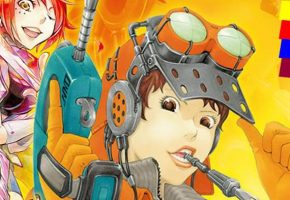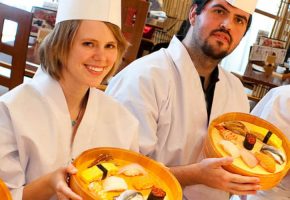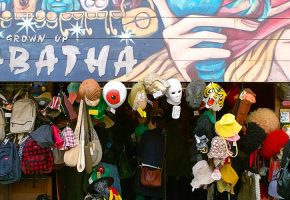Tokyo Things To Do

Cooking course, language lessons and culinary internship in Japan If you are a fan of Japanese cuisine and want to get to know it first hand and in depth, this program is just right for you! You will spend the first month in Tokyo, taking part in a cooking course and in Japanese language lessons. You can decide whether you prefer to stay with a Japanese host family or, more affordably and independently, in a sharehouse (self-catering). The basic Japanese language skills that you acquire through the participation in the language course is required for the second part of your stay in Japan - the restaurant internship on rural Sado Island. Additionally, you can book a 4-week Japanese culinary vocabulary course with 2 sessions of 45 minutes per week, where you will specifically learn Japanese culinary terms. You will then spend the second and third month on Sado Island on the west coast of central Japan in Niigata Prefecture. Sado is a picturesque island with a strong local culture and is also particularly known for local seafood specialties (shrimp, crabs, squid, fish, oysters, abaolone and turban shellfish) as well as seaweed such as wakame, mozuku and iwanori, shiitake mushrooms, traditionally grown rice and persimmons. Sado has several producers of sake, igoneri (seaweed jelly), meat products and other local specialties. Many domestic Japanese tourists travel to Sado for culinary experiences. You will do an internship in a typical Japanese restaurant that specializes in yakitori, ramen, sushi, gyoza or other Japanese or local specialities. There are also two culinary day visits included in the program. You will live in an apartment or in a temple's guesthouse, depending on the location of your internship restaurant. START DATES 2025: October 31 and November 28 2026: January 2, January 30, February 27, March 27, June 5, July 3, September 4, October 2, October 30 and November 27 BOOK NOW! ITINERARY Day 1 - 3 Arrival in Japan, accompanied pick-up from Narita or Haneda airport by public transport and escort to your accommodation (you can choose between a Japanese host family including breakfast and dinner, accommodation in a single room) or a sharehouse (accommodation in a 4-8-share dorm room together with other foreign interns). Saturday and Sunday at leisure. Day 4 - 28 Monday to Friday you will join our intensive language lessons from 9:10 to 12:40 (a total of 20 lessons x 50 minutes/week). You can join the course as a beginner, but also at other levels if you already know some Japanese. You need to do a proficiency test if you want to start the course at a higher level than beginner (available up to upper intermediate). Additionally, you will get 2x45 minutes of lessons per week in "Culinary Japanese", including cuisine-related vocabulary and useful expressions for your internship at a Japanese restaurant kitchen. The cooking classes are held 8 times. The English-speaking cooking teacher is a professional chef. Class 1: Japanese food basics The 5 taste concepts (sweetness, saltiness, acidity, bitterness, umami). The 5 colours: red, green, yellow, white, black The 5 methods: bake, simmer, fry, steam, raw Chopstick manners and basics of serving meals Cooking: Grilled fish, steamed egg custard, Japanese mustard spinach with sesame sauce, pork miso soup, white rice Class 2: Easy Japanese dining table setup with rice pot cooking Oyakodon, mizuna and jako salad, instant radish pickles, tofu and shiitake mushroom miso soup. Class 3: Colorful bento with five colors Fried chicken, boiled hijiki, tamagoyaki, boiled spinach, kinpira burdock root, white rice bento Class 4: The concept of "Sashisuseso" Nabe-daki rice, mackerel simmered in miso, meat and potatoes, vinegared seaweed, ginger and cucumber, miso soup Class 5: The role of seasonings in Japanese food and how to make dashi Mixed rice or sekihan, boiled in Chikuzen, horse mackerel pickled in Nanban, clear soup Class 6: Japanese sweets 1 Mizuyokan Class 7: Japanese Sweets 2 Kingyoku and Nerikiri Class 8: Other Japanese dishes Cutlet curry rice and Japanese potato salad or Dumplings and Hiyashi Chuka (Cold Ramen) Accommodation is with your host family (including breakfast and dinner during weekdays and including 3 meals on Saturday and Sunday) or in a sharehouse (shared, self-catering accommodation). The host families mostly live in Saitama, Chiba, Yokohama or in the west of Tokyo. The sharehouse is located in Koto-Ku near Kiba Station. Not included in the price: Commuter ticket for local public transport in Tokyo (between your accommodation and the language school and cooking school; approx. 6500-10,000 JPY for the entire duration). Day 29 & 30 Travel from Tokyo to Sado Island by Shinkansen bullet train and ferry (total travel time approx. 5 hours). You pay for the train and ferry costs yourself, around 14,000 JPY. We will pick you up from the Sado Ferry Terminal (Ryotsu) and drive you to your accommodation on Sado. Accommodation is chosen depending on the location of the restaurant where you would do your internship. In case of the central Sado and Ryotsu area, you will stay at a self-catering rental apartment, single room. The apartment are two-room apartments where you will share kitchen, toilet and bathroom with another participant of the program. In case of a restaurant in the Ogi area of Sado, you will stay at the guesthouse of Chokokuji Temple at a single bedroom, sharing sanitary installations and kitchen with other participants. In case your accommodation and restaurant is in the central Sado or Ryotsu area, you can reach your restaurant by walk, bus (communiting costs at your own expense) or bicycle (provided to you free of charge if needed). In case of the Ogi area, you reach your internship restaurant by bicycle (provided free of charge). Days 31 - 89 You will do your restaurant internship. You will be in the restaurant 4-5 days a week for 4-8 hours each as an assistant to the local chefs. Japanese restaurants typically only prepare one type of food, so the restaurant where you will do your internship will most likely specialize in one certain type of food only such as Yakitori, Ramen, Sushi or Gyozo. Once a month there is a full day trip (included in the price). The date will be decided depending on the availability of all internship participants. First month: Natural herbs collection in the forest and visit to/workshop in a herbal tea factory Second month: Traditional rice cultivation / harvest (depending on season) Accommodation at your apartment room or at Chokokuji Temple. Day 90 Transfer to Ryotsu Ferry Port in Sado and return travel to Tokyo (at your own expense) for your outbound flight (visa validity for most nationalities is 90 days, so please make sure to book your return flight accordingly) You can do this program on a Temporary Visitor Status or Tourist Visa (or other long-term visas for Japan that you might arrange on your own). If you are unsure about possible visa options for your nationality, please consult with WORLD UNITE! before booking the program. RATES For 1 person: 2980 USD For 2 persons: 2880 USD for each Host family accommodation (for 30 days): +769 USD Japanese culinary vocabulary course: 140 USD Do you want to join this Culinary Internship? Contact us now!
In Tokyo, you can join a 1-3 months course combining MANGA DRAWING and JAPANESE LANGUAGE LESSONS! " order_by="sortorder" order_direction="ASC" returns="included" maximum_entity_count="500"]The course is an exclusive cooperation between Mangajuku, the number one Manga School of Japan, located at Jimbocho in central Tokyo, which has brought fourth many professional manga artists, and a well-established Japanese language school. For this course, a professional manga artist joins force with a bilingual (Japanese + English) coordinator, so you can join this course without having any Japanese language skills. While studying Japanese language in the mornings (20 hours per week), you learn how to draw manga characters, to develop storylines, draw backgrounds, from analog to digital. The manga drawing classes are in the afternoons (the 4 weeks course includes a total of 5 manga lessons; 8 weeks 10 manga lessons; 12 weeks 16 manga lessons x 120 minutes). The course is available for everyone from the age of 15, both for complete beginners in drawing, as for those who are experts at drawing but would like to broaden their expertise in Japan. Also, the language lessons exist for different levels, from beginner to upper intermediate. The rates for the course (Japanese + Manga) are: 4 weeks: 162,000 Yen 8 weeks: 284,000 Yen 12 weeks: 416,000 Yen The next start dates are: 2025: October 6 2026: January 13, April 6, July 6 and October 5 NOW BOOK THIS COURSE! Details about the course: 1. Orientation to the course and outlook of Japanese Manga Self-introduction of the participants and orientation to the course. Exercises. Drawing with a dip pen, filling in procedure, whitening out with liquid and screentones. 2. Character faces How to draw the face. Deformation theory and expressive techniques to show human feeling such as joy, anger, sorrow and pleasure. 3. Drawing the character as a whole Positioning technique of the whole character. Head and body and their proportions. Deformation and attractive poses. 4. Character design 1 Methodology of characterization through fashion, body shape and hair style. 5. Character design 2 Drawing the character in different thema of Japanese Manga. The 4 weeks course finishes here. If you continue, you will learn the following contents: 6. Character motion Practice in drawing running characters. Practice in creating the side composition, or composing from a previous composition. 7. Professional Character Design Actual hands-on experience with a professional manga artist. Lecture about the typical work of a professional manga artist. 8. How to draw the background The basic methodology of background art (clouds and skies trees and leaves, seas and waves. Shaving technique using screentone. 9. Scene allotment Basic description of the panel layout. Trial production of 1 page scene allotment based on an existing story. 10. Digital production (monochrome) Drawing Manga using "CLIP STUDIO PAINT", a piece of computer software. The 8 weeks course finishes here. If you continue, you will learn the following contents: 11. Graduation project 1- monochrome (Draft) Making a cover page of the manga in your debut as a professional manga artist. Drafting with a pencil. 12. Graduation project 2 (Pen lining) Making a cover page of the manga in your debut as a professional manga artist. Pen lining, putting in title (in case of handwritten) 13. Graduation project 3(Digital color)1 Coloring of the project work by a computer. Coloring of the cover page. 14. Graduation project 3(Digital color)2 Completion of the digitally colored graduation project. 15. Field trip Observation trip regarding manga history and viewing of videos for drawing manga. 16. Final comment and graduation ceremony Review and comment on each graduation project. Presentation of the completion certificate for the course. Do you want to join this Manga Course? Contact us now!
In the 90’s and 00’s car tuning and car collecting hit its peak. The Japanese way of car tuning and customization became a worldwide phenomenon. Most people might remember the movie Fast & Furious: Tokyo Drift from 2006, which was made upon the hype. The ones, who remember this movie, can recall how the tuning scene looks like and how the underground environment played out. The history With world-famous brands such as Nissan, Toyota, Mitsubishi, Honda, Lexus, Mazda and Daihatsu, Japan is a car manufacture country. Some of the country’s economy is built up around cars, which have had a huge impact to people of Japan. After the war Japanese men started to tune their cars, which escalated to the huge trend and obsession, that it became. In the late 80’s the trend was about to enter its prime. In 1989 the /Midnight club /was established, which was a very exclusive car club for enthusiasts of car tuning. The club arranges meetups and races, which was the main purpose of car tuning The obsession Japan has a word called otaku, which translates to nerd, geek and enthusiast. Otaku is more of a culture than a word, which applies to these car enthusiasts. The Japanese culture is very much competitive, and kids are taught from a young age about being the best and winning. This cultural dimension also applies to the car environment, where everyone involved want to have the fastest, coolest and most admirable car. There are different aspects of tuning and customization. Some like to buy vintage cars and rebuild them after their taste, while others have the latest Porsche or Lamborghini. Japanese car manufactures have through time created some iconic cars within this environment. If I mention cars like Skyline, Supra and RX-7, you can properly recall, who the manufacture is, and what it looks like. At the same time some Japanese people are not tuning and customizing to show off, but simple for their own amusement. They often collect antique cars, bring them to their garage and just simply make them look nice. Maybe if the cars are beyond nice, they bring it to one of the very popular car exhibits. The supercar-era Street racing and tuning peaking in the 00’s and kind of died out in the start of the 10’s due to improvement of police effort. The police brought more attention to the issue of street racing by bringing more officers on the street and step up their own car collection. For instance, they started using Nissan GTRs as police cars. In that way they could keep up with the racers. For some years there was an empty unfilled space in the car community. At the same time the racers from the 90’s and 00’s had become older and lost their interest in dangerous street racing. Therefore, a natural change happened, where the streets took quiet and the racers as well. As far as I am concerned the streets are still quiet, but the obsession with cars are not. The culture has just changed to a more radical self. With that being said some of the streets of Tokyo are still buzzing with noise from supercars. Rich people are still showing of their million-dollar cars. Take a walk in the wealthier area of Tokyo and the supercars will be driving by you constantly. Especially the areas Roppongi, Omotosando and Daikanyama are filled up due to the residencies of wealthy people. Don’t be surprised if the next three cars passing by you is a Ferrari, Porsche and Lamborghini. Showing off Showing off properly is a bold way to put it, but Japan have numerous car exhibitions every year. The biggest one is called /Tokyo Motor Show /and is held on Odaiba in Tokyo. Here is a list of exhibitions and locations: Tokyo: * Tokyo Auto Salon, Makuhari Messe, January * Automotive World, Tokyo Big Sight, January * Tokyo Motor Show, Tokyo Big Sight, October * Toyota City Showcase, Mega Web Odaiba, All year Nagoya: * Automotive World, Port Messe Nagoya, September * Nagoya Auto Trend, Port Messe Nagoya, February Osaka: * Osaka Automesse, Intex Osaka, February * Osaka Motor Show, Intex Osaka, December
If you want to learn how to prepare Japanese dishes such as Sushi, Tempura, Ramen, Udon, Bento, Soba, Wagashi (Desserts) or even learn the art of the Japanese tea ceremony, we recommend airKitchen, a website where local private hosts, but also restaurants with master chefs, offer cooking lesson to foreigners. The costs start usually from around 3000 JPY for a 1.5 to 2 hours course including the ingredients, but there are even cheaper listings. Lessons can however also reach 24,000 JPY or more for a 2 hours class taught by a master sushi chef. Lessons on airKitchen are listed in Tokyo, Kyoto, Osaka, Sapporo and many other cities in Japan. https://airkitchen.me
Many people are into second hand clothes shopping: It's cheap, it's original, and it is often something you do not see everyone else wearing! Especially as a Working Holiday participant, you might want to spend money on travelling instead of expensive clothes, so we found a place where this is possible. Hipster of Tokyo If you like affordable clothes, then why not try out second hand shopping? In Tokyo, the neighbourhood Shimokitazawa is known for it's many second hand shops, cafés, and young hipster people. It is also known for live music and theater. So on a sunny Saturday, my roommate and I decided to find this place. The way there is very easy: A walk from the World Unite! share house to Kiba station, then 2 different trains, and we had arrived to Shimokitazawa station. Then we basically just walked out of the station, and were met by several second hand shops, good smells of sweets and coffee shops, and a great deal of people. We chose a random street, and then we started looking around. There was a mix of second hand shops and "normal" shops, cafes, restaurants, convenient stores etc. We went into different shops, and could see the originality of the clothes, and also how different it was to what is usually seen in the streets of - for example Kiba, where most people only wear black, white and grey. So far we could already tell that the place is perfect for people who like fashion! Colours, colours, and more colours We went past so many shops, and found a dress shop that we decided to check out. The amount of different colours were outstanding! I was wondering how people could possibly wear such flowered and coloured dresses, but it actually looks really good on many people here. In the streets we also saw people wearing original outfits, but most of the people walking in the streets did not look specifically hipster. After walking a lot, we decided to take a break at a crepe cafe. Everything was baby pink inside the cafe. A friendly male cashier greeted us when we came in, we ordered our chocolate crepes, and then we realised that all the customers were female. It was like a little girlie spot, with a beautiful lamp, small pretty details, and best of all - the smell of freshly made crepes. The place was so cozy and people looked to enjoy a lot. New York Joe Exchange One "Must-Visit" second hand shop is the New York Joe Exchange. We went there, and the place was packed! People were standing in line to look at all the colourful hipster clothes, and the line to the fitting room was long! Also, there was loud rap music and people seemed so excited to shop there. That is a place that no one who visits Shimokitazawa should miss! Sadly, we did not find anything we wanted to buy, but it will probably be a better idea to visit the shop on a weekday, and not on a busy Sunday. But it was nice to see, and we were happy that we went there. That was the last stop at our little day trip to Shimokitazawa, and we went home with yet another experience. About the Author Christina is 26 years old, originally Kenyan/Danish and she is currently interning for World Unite! in the Japan Tokyo Office. She is helping participants who do a Working Holiday in Japan through World Unite!, and when she is in the office she helps out with administrative work and social media marketing. Title picture: Guwashi99; creative commons.
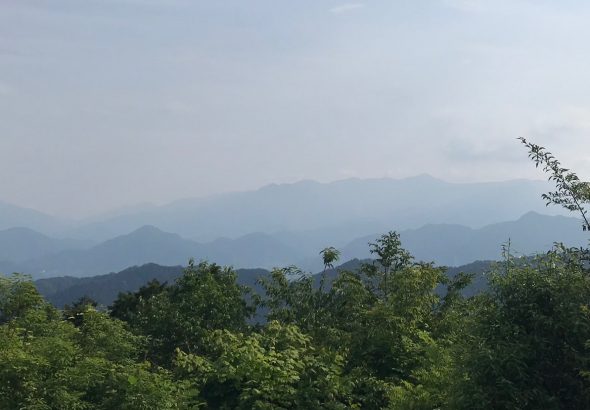
Japan sure has many things to offer! Everything from manga and anime, to robots and mountains! Have you for example ever heard of a 599,15m high mountain one hour away from Tokyo? I sure had not, but then someone from my World Unite! sharehouse talked about his great hike on Mount Takao. So - that is basically how that idea was planted in my head! Step 1: Find the Mountain! I am staying at the World Unite! sharehouse in Tokyo - now it is my second month here, and every weekend I do my best to plan the most interesting things to do! I do not mind if it is being touristy, as I will only be staying here for 3 months, so I do not see myself as anything else than a tourist! I just want it to be fun and exciting. So, last weekend the menu was: A mountain climb! My World Unite! sharehouse roommate and I wanted to climb Mount Takao, so we packed our bags with water and food, charged phones, good mood, and we were ready to go. From our sharehouse in Shiohama to Takao Station took approximately 2 hours, with a little train confusion on the way - but we made it! The day was hot and humid like many other days during the late Japanese spring, so we were happy and ready to explore a nice and cooler area in Kanto! When we finally arrived, my roommate did not feel very well so we decided to split up. My roommate explored the area around Mount Takao, and I climbed it. Usually, I am not a big fan of doing things all by myself as I actually really enjoy experiencing with friends or family, because then you can share the experience afterwards, and create memories together that way! But that day I was on my own! Of course, I had my very best friend in Japan with me, Google Maps, that (again) did a good job in supporting me. So, let me just admit it: the hardest thing on this little trip was to find the mountain. Where should I start? Google Maps showed me that it would take around 2 hours to get to the top, so I just started to follow the blue dot, and I ended up in a place with music and lots of people - and a path! So it looked like I found the way up. Step 2: Climb it So now you are probably thinking: 599.15 m, that is just a small hill - and now is the time I will advise you to google Mount Takao. It is an actual mountain, and it was an actual climb to the top! As I had finally found the path up, the next step was just to climb it. So I started walking comfortably up, and weirdly enough, most people were walking down. But as I looked behind me I could see that I was not the only one climbing it, so I could not be totally lost! I walked and walked and it was so so steep! I was even sweating and I was very happy that I brought a bottle of water. The place was beautiful though - so much nature! I could hear birds singing, the wind in the trees, and I could look up and see the sky which was totally blue. I was feeling very happy, and I did not have to worry about getting lost, because as long as I was walking up, I would reach the top at some point. So I continued walking, continued sweating, and continued enjoying! After some time, I reached a viewpoint from where I could see all over Tokyo - it was so beautiful! I met a nice American couple and asked them to take a photo of me, and then of course I took one of them. They were so friendly, and told me that they were living in Tokyo and then they wished me a good stay in Japan, and we went our separate ways. I decided to take a little break, eat some lunch, and enjoy the view, and then I continued up. Step 3: Yakuoin Soon enough, I reached this beautiful Buddhist temple called Yakuoin. It was so nice and there were many people there. I walked around, looked at people, and took everything in, as it was probably a once-in-a-life experience to be there (except that I had to pass the place when going down again, minor detail)! I had read that many people visit the temple to pray to the Buddhist mountain gods, and I could also see some people praying when I was there. After exploring the temple I continued further up, and there were lots of stairs to ascend. I did not want to be slow, so I passed many couples enjoying a climb, old people taking a walk, and also other tourists like myself. The funniest thing I saw was a lady who was taking her rabbit for a walk. Yes, you read that correctly, it was a rabbit. And no, it was not a small dog that I thought was a rabbit! It was an actual rabbit, and she had it on a leash and then she was carrying a little basket - probably so the rabbit could be carried if it felt tired. Of course, there were also people walking with their dogs in baby carriages (I guess it should be called dog carriages?), but I got used to seeing those in Tokyo by now! Step 4: All the way up Finally, I saw a sign saying "Top of Mt. Takao", and I knew I was close. Just a few more stairs, and then I was there! I walked to another viewpoint and it was so so amazing. That was one of those views that a photo just cannot catch! It was something you simply have to experience for yourself. I was so happy that I made it there, and I just really needed to share it with someone. So I called my family back home, and I told them how amazing it was, and then I felt even happier after the talk. It was also here that I found a friendly-looking person who took a photo of me at the top. It was so cool! I spent some time there enjoying the feeling until I was ready to go down again. Step 5: Down The way down went so fast! It basically felt like squatting all the way down, because I really had to control my legs so they would not just start to run away from me. It felt funny, and it was actually almost as hard as going up - just in a different way! But I made it down in no time. I walked and walked, back to the station, where I met with my roommate again, and we decided to spend money on discount ice-cream which was 100% worth it. So, all in all that day was just amazing, and it was a very amazing experience! I will definitely recommend everyone coming to Japan to try to climb Mt Takao. Oh, and a little side note; I found out that there are actually much easier ways up that the way I chose! Apparently, the path I used to go up, was a hard one, and my sharehouse-mates told me that there are other paths - a lot less steep. Good to know! About the Author Christina is 26 years old, originally Kenyan/Danish and she is currently interning for World Unite! in the Japan Tokyo Office. She is helping participants who do a Working Holiday in Japan through World Unite!, and when she is in the office she helps out with administrative work and social media marketing.
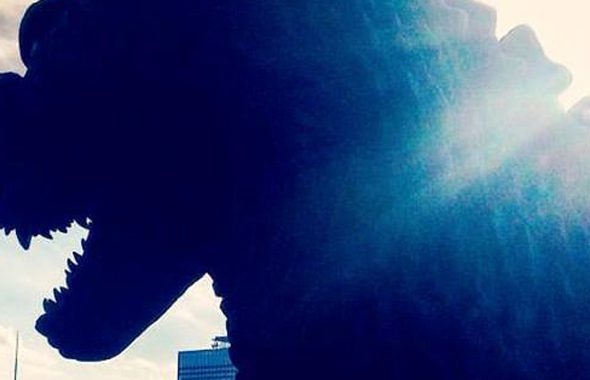
Most people who come to Tokyo know of the Skytree, the Tokyo Tower and the Shibuya Crossing with loyal Hachiko statue. Those are of course awesome places to visit when you are here, but how about some lesser-known but amazingly Japanese sights in the concrete jungle? Let me introduce to you these 5 quintessential Japanese scenes in the middle of Tokyo! 1. Bonsai Trees in Happo En This is one of the best places to see bonsai trees, as some of the trees that are on display here are already 500 years old! Pruned to perfection using traditional gardening techniques, these trees are more like masterpieces of art than anything else. Imagine all the work that went into a tiny tree that's hundreds of years old and grows exactly the way the bonsai expert wants it to grow. It is not a coincidence that an art that refined originated in partly Buddhist Japan. Besides the bonsai trees, the rest of the garden is also perfectly landscaped. It is no wonder that this is also a very popular place for young couples who can afford it to get married here and have their pictures taken in the garden. If you are lucky you might catch a few weddings and see what a bride and groom look like in their Shinto wedding dresses. They often pose near the pond full of happy and healthy koi fish. While you are there you should also not forget to stop by the tea house in the back of the garden and have a cup of matcha tea with some of the best Japanese sweets available in the city. The lady will serve you using Japanese-style small movements, where not one movement is unnecessary. Add to this the view, and you're all set for a perfect afternoon tea! 2. Godzilla in Shinjuku Ever since Hollywood did a remake of classic Japanese movie 'Godzilla' this legendary beast has been gaining popularity again. This dragon, who is actually a metaphor for nuclear weapons, even has a life-size replica of itself in the middle of entertainment-district Shinjuku in Tokyo. The best part is that it is not just a statue, at set times every day this monstrous movie villain even starts to roar and breathe steam starting at noon, and you shouldn't miss this! Especially at night, it is quite an impressive free show for everyone to see. Go with your fellow Working Holidayers to Shinjuku to watch the spectacle and after that have a yakitori meal in the alleyways of Omoide Yokocho. If you stay in the World Unite! sharehouse you will always be able to find someone who wants to go with you and explore the city. 3. Mario and Luigi in the Streets of Tokyo Even if you have always seen Tokyo as a city that is often featured in video games, you might still be surprised to hear that the streets of Tokyo do actually look like a real-life video game at times! It's only been a few years since the first Mario carters were spotted, and nowadays they became a part of daily Tokyo traffic. If you bring an international driving license to Japan, you will be able to dress up like your favorite Mario Cart character and drive the streets of Tokyo with an actual go-kart. So when you have a driving license and come to Tokyo, make sure to bring your international license and be part of the real-life Mario cart craze! 4. Japanese Idols in Akihabara For those who are not in the know, Japanese idol bands are (usually) large groups of high-school aged girls who mainly appeal to middle-aged men who are looking to relive their good old young days. The music they produce is maybe not the best, but the cuteness of the girls is enough to draw large crowds to their concerts. Akihabara is the birthplace of one of the most iconic Japanese idol bands: AKB48. The group's name stands for Akihabara (AKB) and the number of members (48). The girls are continually replaced as they become too old around age 24. Those who retired or didn't quite make the cut sometimes become waitresses at the AKB48 cafe where above picture was taken. This cafe doesn't only serve cute dishes that are said to be band members' favorites, but they also organize quizzes about the band and small performances on their in-cafe stage. 5. Votive Tablets Adorned with Anime in Kanda Every shrine (Shinto) and every temple (Buddhist) has their own image on the ema (votive tablets) that people use to write their wishes on. Usually this image has a relationship with either the temple or shrine itself or the neighborhood the temple or shrine is located. As the Kanda shrine is located near anime fan paradise Akihabara, the ema here are decorated with anime pictures. Some of them have been drawn by the fans themselves and are quite impressive. It is an interesting combination to see, a traditional solemn shrine coupled with these colorful, modern pictures! About the author Stefanie has lived in Japan since February 2013, and after starting the Japanese adventure in Nagoya she happily settled in Tokyo in 2014. She loves exploring the city, and besides her work as a coordinator for World Unite! she also works as a tour guide in Tokyo. If participants of the World Unite! program in Japan have questions about exploring Tokyo, they can always ask Stefanie which places can't be missed. She also believes that the best Working Holiday experience includes not only work to boost your skills and resume, but also plenty of exploration of Tokyo as well as the rest of Japan.

Isabel (19) from Germany: "What I find so great about karaoke is that you don't have to be a great singer to have fun with it. You always go with friends as a group and it is particularly fun if you cannot sing, because everyone will join singing and bawling out, especially in case of songs everyone knows such as famous anime openings. It's always super fun. My favourite songs are the songs of Nishino Kana. The Karaoke shops always have some of her songs. Sometimes they also have some Western songs that you can sing in English. I also enjoy to sing Anime openings. There are plenty of Karaoke shops all over Tokyo. Just around the corner of our share house in Kiba there is a Karaoke place. In Shinjuku and Shibuya you find at least one Karaoke shop at every corner. Many of them belong to a chain of Karaoke shops. Choosing them you'll be on the safe side to have a fun time. However, there might also be cheaper non-chained places that are also good. Often you will find karaoke + a drink, or "All you can drink + karaoke", which is always the option that is most fun!" " order_by="sortorder" order_direction="ASC" returns="included" maximum_entity_count="500"]

